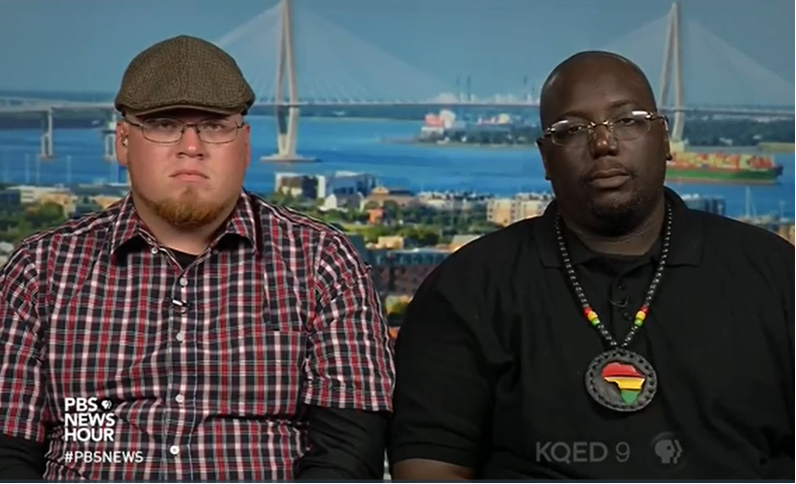After the Fire: NewsHour Coverage of Civil Unrest in America, 1991-2021
Charlottesville
Sparked by the growing radicalization of white nationalist groups and their explicit expressions of white supremacy following the 2016 election, in August 2017, an alt-right group gathered in Charlottesville, Virginia, to oppose the removal of the Robert E. Lee statue in the city. This statue was one of many Confederate monuments removed or slated for removal at the time. Counter-protesters later arrived on the scene to disrupt their rally and their racist, anti-Semitic messages. Following violent clashes that resulted in the murder of counter-protester Heather Heyer after a white nationalist drove a car through a crowd of counter-protesters, the NewsHour took a closer look at the rise of white supremacy in America. It hosted a discussion on growing racial tensions and interviewed professor of sociology Michael Eric Dyson to get his perspective on the recent actions of white nationalists in Charlottesville.
In a “Race Matters” segment, the NewsHour hoped to find potential solutions to this growing racial divide by inviting James Bessenger of the South Carolina Secessionist Party and Shakem (Johnathan Thrower), a Black nationalist, to discuss how they have been working together to prevent future Charlottesvilles. They described their initial reactions to each other and the ways they have attempted to bridge the divide:
Bessenger: “I heard from him the first time. We got to know who each other was a little bit, and it was the first time I heard someone on that side of the debate who didn’t describe me as a racist, fascist, or neo-Nazi. So it was refreshing to find people on the other side of the debate to pay attention to where we were coming from without jumping to conclusions.”
Shakem: “It’s hard. When I look at a white person with a Confederate flag, it brings up a lot of emotions because that brings images of an enemy, and you know, in spite of the fact that all of them aren’t Klansmen or K.K.K. members, it’s something you have to get over psychologically in your head especially as being a Black person. So that was something that really kind of, you know, took me a moment to get over, and also we, you know, we have a lot of issues with the Klan here in South Carolina. It was just something that really took something in me to sit down and say, okay, let’s see how this issue of race can actually be resolved without coming to blows.”
 |
At the center of the Charlottesville incident was the debate over the preservation of Confederate monuments, of which the NewsHour did its own analysis. To provide context to these debates, correspondent William Brangham spoke with historian and author Edward Ayers, who provided some history of the Civil War and of Confederate monuments. In “Grappling with History,” Brangham moderated a conversation on whether or not these monuments should be removed, getting perspectives from both sides of the controversy with guests debating their historical value. Correspondent Jeffrey Brown continued this discussion, reporting from Kentucky where he spoke to Professor Ricky Jones and Mayor Ronnie Joyner, two men with very different opinions on the tearing down of Kentucky’s 70-foot-tall monument commemorating Confederate soldiers. The other thread that came out of the Charlottesville coverage was the NewsHour’s investigation of the increasing threat of domestic terrorism and efforts being made to counter this extremism using social media.
From 1991 to 2021, these incidents of civil unrest served as catalysts for the NewsHour’s critical exploration of the relevant social issues and controversies of the day. Starting in the early 2000s, the NewsHour increased the number of segments per episode in order to examine a greater number of newsworthy events each day, and the series was forced to shorten the length of each segment to fit them within the hour-long time frame. As a result, the NewsHour had fewer opportunities to provide in-depth analyses of civil unrest, which helps explains why, following the L.A. Riots, few other events received the same high level of in-depth coverage. As seen in some clips included in this exhibition, the NewsHour compensated for these shorter segments by encouraging viewers to visit its website and social media platforms, which featured articles and specials that further investigated the causes and effects of these events. (See the additional resources in this exhibit and the PBS NewsHour website.) Even with these shorter timeframes, however, the NewsHour stayed true to its mission and continued to provide thorough news coverage that sought to explore these events in their entirety by getting the perspectives of people from all sides of the issue.
The following Annotated List of Events provides a chronological listing of NewsHour coverage of civil unrest from the 1991 Crown Heights Riots to the January 6th U.S. Capitol Insurrection.
